La Comisión Monetaria
by Cedrian López Bosch
After the failure of the introduction of the so-called infalsificables in 1916, given the difficulties in creating the Single Bank of Issue included in the Constitution of 1917, and with the pressing need to replace the silver coins that in the second half of 1919 were disappearing from circulation because of the rapid increase in international prices, in January 1920 the Monetary Commission (Comisión Monetaria) made a provisional issue of paper money in two denominations: fifty cents and one peso.
The Monetary Commission was created by Venustiano Carranza by means of a decree published on 4 April 1916, to reorganize the circulation of fiduciary currency in the Republic:
To collect, maintain and administer the funds designated by the Government to stabilize and guarantee the internal circulation and serve as a conduit for the General Government to issue and withdraw fiduciary currency, as well as to make the necessary fractional currency issues for circulation; To place funds both within the country and abroad; To buy and sell money orders; To carry out operations with metallic species and fiduciary currencies, and in general to carry out all banking operations of exchange of currency that are conducive to the purposes of the Commission; To execute through the respective offices all the operations of amortization, exchange, seal and contrast of the fiduciary currency.
Originally, it was formed by the Minister of Finance, Luis Cabrera, the General Treasurer of the Nation, Nicéforo Zambrano, and three (actually ended up being four) members appointed by the President: Alberto Pani, Director of the Constitutionalist Railways, Ignacio Rivero, Carlos B. Zetina and Carlos Basave. Its managers were Eduardo del Raso and Francisco Puga.
The Commission focused on arranging the monetary circulation after the chaos of the revolutionary issues. This meant exchanging and destroying obsolete currency; issuing, exchanging and withdrawing the infalsificables; and reintroducing metallic gold and silver coins. It also helped the Ministry of Finance to wind up the private banks of issue and performed financial, credit and banking activities for which it created a network of branches throughout Mexico. Eventually, it was the basis of the Banco de México, the single issuing bank established in the constitution.
Printing and issuing the vales
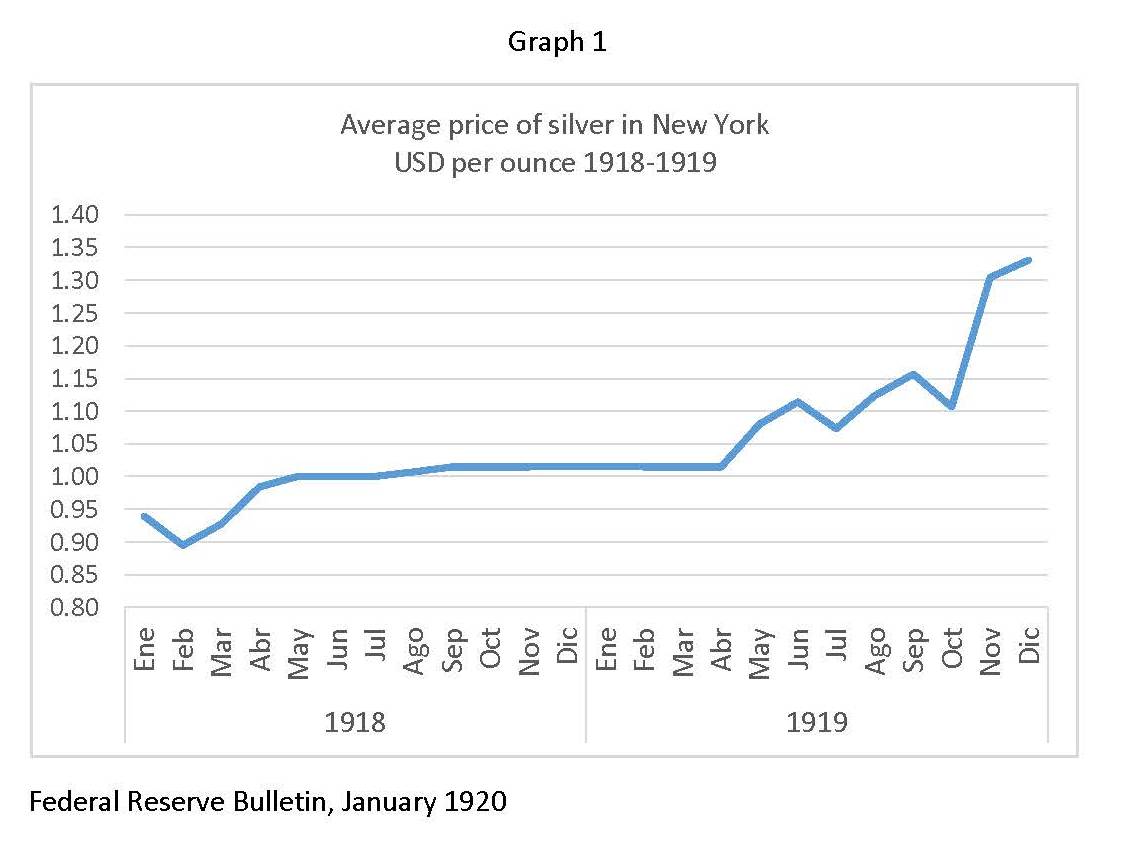
Despite the efforts made by the Monetary Commission to restore the circulation of metallic coins, the increase in the international price of silver from 1918, and particularly in the second half of 1919 (Graph 1), even above its face value, caused the hoard and export of silver coins, that basically disappeared from daily transactions. In October 1918, the government responded by reestablishing the gold standard, at the same parity of 1905, and creating new coinage. While gold coins of 2 and 2.5 pesos were announced, only the latter were coined in November and December of that year and again from September 1919, while the former did not appear until November 1919. The government also reduced the weigh and silver content of coins; the old 24.4338 grams and 0.9027 silver fine pesos were replaced by 14 grams and 0.800 silver fine pesos in November 1918 and by 12 grams and 0.720 silver fine pesos in October 1919. Given the continued increase in the price of silver and the uncertainty about its future course, the government almost suspended the minting of silver coins and despite the general suspicion on paper money, surprising everyone, on 10 January 1920 Carranza issued a decree authorizing the Commission to issue vales (vouchers) payable to the bearer with a nominal value of $1.00 and fifty centavos national gold, as a fractional species of the gold coin deposited with the Commission.
On 13 January Charles Blackmore, the ABNC’s Resident Agent in Mexico City, reported that “This decree has come as a surprise to everyone, for although Mr. Cabrera a few days ago stated to the press that he had a surprise for the public he has, on several occasions, declared that he was not going to issue “paper money”, and when I last called on him a short while ago he told me he had no business for me. I was, therefore, disagreeably surprised when I saw that preparations were being made to print certificate in the Government Bureau of Engraving and Printing in this City"ABNC, folder 210, Republic of Mexico Bank Notes Including Comision Monetaria – “Cabrera Vales” (1920-1940).
A proof of the 50c note had Mexican images, including the Aztec stone calendar, on both sides, which had been used on the British American Bank Note Company's proofs for the $100 Banco de la República Mexicana.
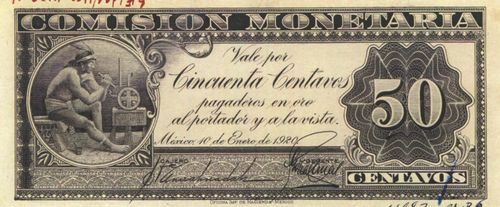
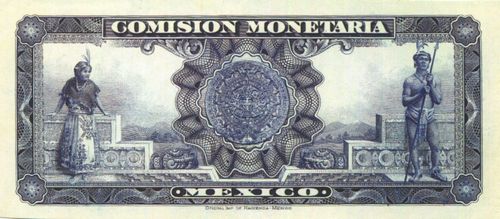 M4285.5 50c Comisión Monetaria proof
M4285.5 50c Comisión Monetaria proof
The final 50c vale has a bust of the goddess of wisdom, craft and war, AthenaCharles Blackmore, ABNC’s representative in Mexico, claimed this vignette was a copy of ABNC’s vignette C-986, used on the reverse of the 1905 Greece’s five drachma banknote (P-54) and looks like the one used in the 50c note of the Banco Minero Chihuahuense in 1880 and in the 1883 two pesos from the Banco Mejicano., on the left side and a rosette with the number 50 on top and the word "CENTAVOS" on the right. The signatures of Luis Gónzaga de la Canal and Santana Almada, Cashier and Manager of the Monetary Commission respectively, appear at the bottom below the legend over a micro text saying “ESTADOS UNIDOS MEXICANOS”.
| Luis Gónzaga de la Canal | 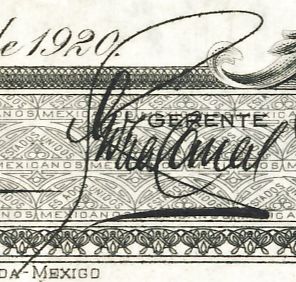 |
|
Santana Almada On 9 September 1920 Almada was listed as a probable Secretario de Hacienda in Obregón’s cabinetEl Informador, Año III, Tomo XI, Núm. 1066, 9 September 1920. Surprisingly, or unsurprisingly, most of the people mentioned as potentional cabinet members, had been connected with the issue of paper money “En los círculos políticos, se designa como probables miembros del Gabinete del ciudadano general Obregón, a las siguientes personas: De Relaciones, señor Adolfo de la Huerta; de Guerra, general don Plutarco Elías Calles; de Gobernación, licenciado don José I. Novelo; de Agricultura, ingeniero y general don Amado Aguirre; de Industría, ingeniero don Alberto Pani; de Comunicaciones, ingeniero y general Pascual Ortiz Rubio; y de Hacienda, señor Santana Almada.”. |
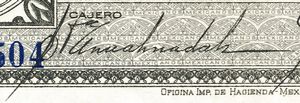 |
These vales are printed on watermarked paper (see below), with black ink on the front and green on the back, with the serial numbers printed in blue ink.
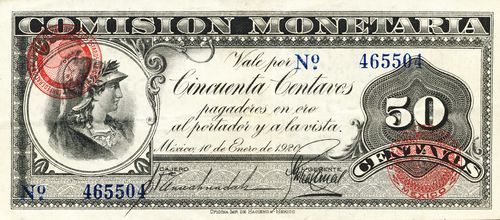
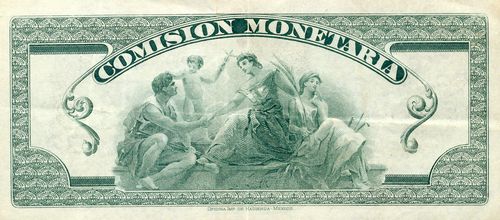 M4285 50c Comisión Monetaria
M4285 50c Comisión Monetaria
The one peso vale shows a vignette of Tyche, goddess of Fortune, represented by a woman holding a cornucopia and two cherubs, with the same signatures and microprinted text of the fifty centavos notes. The face is printed in brown, the reverse in blue as well as the numbers.
The reverse is the same on both notes with a classic scene with four figures, a man holding the hand of a young woman, a boy and a second young woman sitting next to the first. The difference between both denominations is only color and while the fifty cents voucher has the two circular stamps on the front, one with the legend "COMISION MONENTARIA - MEXICO" and the other "CONFEDERACION DE CAMARAS DE COMERCIO DE LOS ESTADOS UNIDOS MEXICANOS", the voucher of one peso has them on the reverse, in both cases in red ink.
The Confederation of Chambers of Commerce's involvement was vital for the issue. On 27 February Blackmore reported “The Confederation of Chambers of Commerce still continues to supervise the printing, sealing and distribution of the Vales. This Confederation is composed of 45 Chambers of Commerce established throughout the Republic; 12 Chambers have voted against the participation of the Confederation in the supervision of the Vales issued, and 14 have voted in the affirmative, authorizing the Confederation to supervise the issue. Nineteen Chambers of Commerce have not yet arrived at any decision regarding this matter.
As the total number of Chambers represented is 45, one half plus one, or 23 must be negative to compel the Confederation to cease its work. If this should happen then the issue of the Vales will be killed.”ABNC, folder 210, Republic of Mexico Bank Notes Including Comision Monetaria – “Cabrera Vales” (1920-1940).
These vales have an important relation with a previous issue, the one of the Banco de la República Mexicana. The vignette of Tyche is the same that was suggested for the five peso bank note of this bank. This vignette was engraved by the British American Bank Note Company (BABNC), established in Ottawa, at the request of Fernando Fernández, Chief of the Engraving Office of the Government Printing Office when he traveled to the United States and Canada with the task of preparing the banknotes for that first attempt to create the single bank of issue in 1918. I do not know whether Fernandez was aware, but this same vignette was used on a 1898 five-dollar banknote from the Bank of Ontario, also engraved and printed by the BABNC. This shows that it was not a special vignette, but one from the printer’s archivesBlackmore said that this vignette was a copy of one originally engraved by the ABNC (C-986) which appeared on note printed for the Bank of Greece (ABNC, folder 210, Republic of Mexico Bank Notes Including Comision Monetaria – “Cabrera Vales” (1920-1940)). Another element in common was that the vales were printed on a watermarked paper with the text "BANCO DE LA REPUBLICA MEXICANA" that was acquired in the United States specifically to print those banknotes. Finally, the printing of the vales was made at the Printing Office of the Ministry of Finance (the new name of the Government Printing Office)This Office, also known as the Stamp Printing Office, was re-established in the National Palace when Carranza brought the capital back to Mexico City in 1916, after a temporary transfer to Veracruz. at the National Palace, as it was intended to produce the banknotes of that bank.
According to El Universal of 13 January 1920, with its 20 etching presses, the Printing Works could print 250,000 50 centavos or 125,000 one peso vales every dayEl Universal, Año V, Tomo XIV, Núm. [ ],13 January 1920. Nevertheless, it seems that the intention was to use a rotary printing press purchased in 1918 in the U. S. by Fernando Fernándezibid.: ABNC, folder 210, Republic of Mexico Bank Notes Including Comision Monetaria – “Cabrera Vales” (1920-1940).
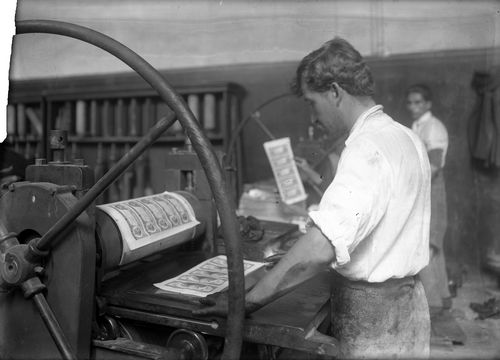
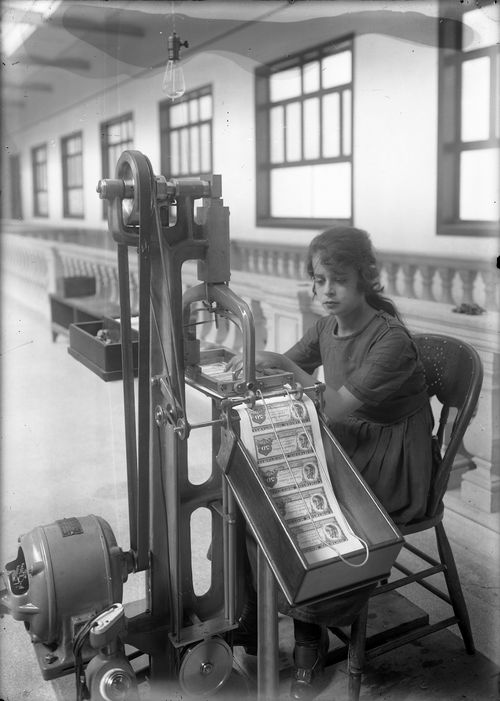
The Printing Office began printing the vales only three days after the decree, on 13 January and delivered them to the Monetary Commission from 20 January onwards. “The $1 vales will not be released for a few days, because it has been considered that the 50c are more urgent, and the twenty presses of the printer that are used in this work can only print about one hundred and twenty-five thousand pesos of peso bills daily. that is half of the 50c issue, and that with intense work. The printing is done in front of ten inspectors: two from the Ministry of Finance, two from the Comptroller's Office (Controlaría), two from the Chambers of Commerce, two from the Treasury and two from the Printer, and from today not a single banknote will come out that has not been reviewed by the delegate of the merchants, who today will be the President of the Confederation of Chambers. Mr. Fernando Leal Novelo, who from tomorrow will be present at the printing of the banknotes. In the Comisión Monetaria there will be two delegates of the Confederation, who will make daily balances and make sure that it is in accordance with the existence in gold and in "vouchers"ABNC, folder 210, Republic of Mexico Bank Notes Including Comision Monetaria – “Cabrera Vales” (1920-1940).
So, on 20 January the Printing Office delivered the first 30,000 50c vales to the Monetary Commission which put them into circulation as soon as it received themA few years ago the 50c vale numbered 000001 surfaced with a handwritten legend "I received this voucher, number 1, launched today into circulation, Base of the future Bank of the Republic" and the signature of Venustiano Carranza., by exchanging approximately 20,000 pesos in gold coins for vales per day. Table 1 reproduces the figures of the delivered and issued vales in the first month, that is, 1.085 million fifty centavos vales and the first 30,000 one peso vales, which reached the streets one month laterAGN, Fondo SC224, Antiguos Bancos de Emisión, Comisión Monetaria, Box 2254, Book 2257, Libro diario 1919-1920, p 293.
| Vales printed and delivered to the Monetary Commission 20 January - 20 February 1920 |
||||
| Date | Denom. | from | to | Face value |
| 20 January | 50c | 1 | 30000 | $15,000 |
| 21 January | 30001 | 70000 | 20,000 | |
| 22 January | 70001 | 115000 | 22,500 | |
| 23 January | 115001 | 160000 | 22,500 | |
| 24 January | 160001 | 200000 | 20,000 | |
| 26 January | 200001 | 255000 | 27,500 | |
| 27 January | 255001 | 295000 | 20,000 | |
| 28 January | 295001 | 335000 | 20,000 | |
| 29 January | 335001 | 375000 | 20,000 | |
| 30 January | 375001 | 410000 | 17,500 | |
| 31 January | 410001 | 445000 | 17,500 | |
| 2 February | 445001 | 505000 | 30,000 | |
| 3 February | 505001 | 540000 | 17,500 | |
| 4 February | 540001 | 575000 | 35,000 | |
| 6 February | 575001 | 645000 | 17,500 | |
| 7 February | 645001 | 680000 | 35,000 | |
| 9 February | 680001 | 750000 | 17,500 | |
| 10 February | 750001 | 785000 | 17,500 | |
| 11 February | 785001 | 820000 | 17,500 | |
| 12 February | 820001 | 855000 | 17,500 | |
| 13 February | 855001 | 890000 | 17,500 | |
| 14 February | 890001 | 925000 | 17,500 | |
| 16 February | 925001 | 975000 | 25,000 | |
| 17 February | 975001 | 1000000 | 12,500 | |
| 18 February | 1000001 | 1035000 | 17,500 | |
| 19 February | 1035001 | 1065000 | 15,000 | |
| $1 | 1 | 10000 | 10,000 | |
| 20 February | 50c | 1065001 | 1085000 | 10,000 |
| $1 | 10001 | 30000 | 20,000 | |
Source: Monetary Commission, Daily journal 1919-1920
This gives a total of $572,500 printed up to 20 February. I have not been able to find another official document that tallies the total number of vales printed and issued. The decree indicated that they could be issued in the amount required, as long as there was an equivalent in gold at the Monetary Commission’s reserves. Therefore, at the beginning the amount could not exceed fifteen million pesos in fifty centavos vales, and ten million in one peso vales. But this figure seems much higher than the amounts apparently issued.
By 16 April, according to the Confederation of the Chambers of Commerce, details wereExcelsior, 21 April 1920:
| Balance in hand in national gold to cover the “Vales” in circulation | $1,292,500.00 |
| Stock of “Vales” of 50¢ | “ 440,000.00 |
| Stock of “Vales” of $1.00 | “ 525,000.00 |
| Total amount of “Vales in circulation and in cash | $2,257,000.00 |
President Adolfo de la Huerta’s State of the Union address in September of that year mentions 2,487,275 pesos issued, that is, printed and delivered to the Monetary Commission, but only 1,342,500 in circulationThe highest numbers I have seen are 1807379 for the 50 centavos and 319620 for the one peso.
Government offices were obliged to receive the vales at par and the Commission to exchange them for gold in quantities of more than twenty pesos, but they were of voluntary circulation among the population. Although the press reported “to this day the vales have been well received and only the lilly-livered and the coyotes try to scatter mistrust. [...] many people have gone to the Monetary Commission looking for vales”El Informador, Guadalajara, 21 January 1920 the truth is that these statements were only from the first day, and they aroused mixed feelings. On the one hand, businesses strongly needed fractionary currency for their activities and contributed to its issue through the Chambers of Commerce. On the other hand, suspiction about paper money persisted among the general population after the tragic experience during the Revolution, in particular associated with President Carranza and Minister Cabrera. In fact, this issue was commonly known as Vales Cabrera.
It is not clear to me how far they reached. Although when these vales were to be issued the press outside Mexico City announced that "every public office [was] authorized to exchange vales for gold in any amount, as well as the Monetary Commission"ibid., 18 January 1920 and several states reproduced in their official newspapers the communications of the Ministry of Finance suggesting they install exchange offices in markets as well as inviting commerce to indicate whether they accepted vales or not, it is said that they only circulated in Mexico City, since it sought to satisfy its demandibid., 30 January 1920 while outside there was either no demand or they preferred metallic or U. S. currency.Excélsior, 21 April 1920 At least, I can say that the government intended to put them into circulation beyond Mexico City as some businesses in Guadalajara, Jalisco, advertised that they accepted valesEl Infomador, different dates, January-June 1920, and the press reported conflicts opposing the introduction of vales in mining centers such as Pachuca, Hidalgo, where the miners refused to accept the vales in payment of their wagesEl Universal, 27 March 1920.
In Mexico City 15,000 trade unionists wrote two memoranda to Carranza, asking for sufficient bronze coinage to be minted for small transactions, and threatening strike action if they were not paid in goldEl Universal, 27 March 1920: Excelsior, 30 March 1920.
In Querétaro a small business, supported by the local Cámara de Comercio, decided not to accept the vales in any of its operations, and as a result the silver that had been hoarded, and the small change (morralla) began to circulate in sizeable amountsEl Informador, Año III, Tomo X, Núm. 910, 3 April 1920.
On 21 April a newspaper reported that lately “it appears that the public does not need more paper money for its transactions, and, therefore, there is no demand for “Vales” from the Comisión Monetaria. It has also been noted that there is no longer the disconfidence which existed at the commencement, for the public of all classes are beginning to accept them without a limitation.”Excelsior, 21 April 1020.
And the American Bank Note Company?
During the time of the private chartered banks in Mexico, the American Bank Note Company ("ABNC") almost held a monopoly in banknote printing, and after the chaos during the Revolution, in which it also participated, there was a new opportunity to retain such a lucrative market. Towards the end of the revolutionary period, representatives from Constitutionalist movement travelled to New York to request this company to print the infalsificables and, after the approval of the new Constitution, the banknotes of the aforementioned Banco de la República Mexicana. However, the former had an ephemeral life and the latter were never put into circulation since the bank did not materialize. After these experiences, and because of the discrediting of paper money among the population, a new issue of Carranza’s government was not expected.
Therefore, as soon as the decree for the creation of these vales was announced, the representative of this company in Mexico, Charles Blackmore, informed the headquarters in New York that this issue had taken everyone by surprise, since Minister Cabrera himself had repeatedly said that he would not issue paper money and therefore had declined the offerings of this companyABNC, folder 210, Republic of Mexico Bank Notes Including Comision Monetaria – “Cabrera Vales” (1920-1940).
The headquarters was distrustful about this issue and, although they asked Mr. Blackmore to find out more about it, they were confident that it would arouse suspicion among the population, both for the lack of security measures and deficiencies of the engraving (although it had originally praised the engraving of the obverse of the fifty cents vale), as well as by the lack of legitimacy of its authorsibid..
Given the lack of urgency to print and deliver the vales from the Printing Office, or more likely to entertain Mr. Blackmore, Minister Cabrera requested a quote for 20 million 50c and 10 million $1 vales with similar features. Blackmore, on 20 March, transmitted it to the New York office, suggesting it quote the best models, at the best cost, and with the promptest delivery possible. "Mr. Cabrera tells me that the Government Printing Office is not turning out the vales which they are printing quickly enough, and he contemplates calling the ABNC to his assistance; his idea being to continue printing the 50¢ & $1 vales just as they are doing at present until you would be able to commence printing. But he can only carry out his plans provided you are able to make the first shipment in a short time and that your prices are not too high on view of the fact that the denominations of these fractional currency vales are only 50¢ and $1.”ibid..
The quotation was 10.50 dollars per thousand units, on planchette paper, or 13 dollars also with multicolored tint, delivered F.O.B. in New York, plus the cost of engraving the plates ($ 3,000, an amount that could be waived to improve the terms of the negotiation) and the seals (75 cents per thousand). Proofs could be ready six weeks after the models were approved and delivered at a rate of 2 to 2.5 million pieces a week, five or six weeks after approving the proofs, a few less if they were multicolored ibid..
The ABNC prepared models utilising the text of the current vales, and on 12 April it sent these two sets, face and back of a 50c and $1. “We think you will agree that the designs represent a marked improvement over the present issue and we believe that the producing of the models at the proper moment may be the deciding factor for the securing of this business. As already advised, however, we would ask you to use care and judgment about letting the models out of your possession as we naturally are averse to giving them ideas to be reproduced elsewhere or placing other vignettes from our stock at their disposal to be copied.
You will notice that the faces of both denominations have been designed in such a way that multicolor tints can easily be added around the counters and if they should decide to accept our second proposition, it will be a comparatively simple matter to alter the models and show the necessary multi tints.
You will, of course, explain to them that the “United States of America” pantograph will be replaced, in case the notes are actually engraved, by the pantograph “Estados Unidos Mexicanos” or whatever lettering they may prefer.”ibid..
On 17 April Blackmore reported that Cabrera had told him the previous night that he would not be placing an order. “After calling on Mr. Cabrera about eight times he at last gave me an appointment for last Friday evening, the 16th., … Mr. Cabrera told me that our prices were too high and that in addition the time of delivery did not suit him. I at once offered to again to take up with you the question of prices and deliveries and then he came back at me with what I think is the true explanation as to why he does not wish to place this order with us. He told me that he now prefers to continue printing the vales himself, that is in the Government Printing Office, as he can print one or two million pesos of vales and then stop the printing if he finds it necessary to do so; whereas if he placed the whole order with us he would have a large stock of paper money which might be no use to him after July.
A week ago a friend told me that Bouligny & Schmidt, (the largest engraving and printing house in Mexico) has stated that I has taken away from them a tremendous bank note order by cutting the prices, and that we has received the order at prices for which it was impossible to print the notes, and that we would, therefore, be furnishing the Government with notes at a great loss to ourselves. This same story was repeated to me by a second person. So it would appear that Bouligny & Schmidt were also asked to bid on the order for the vales, and Mr. Cabrera must have turned them down with the excuse that he was giving me the order. I, for my part, have kept a discrete silence regarding this order.
I asked Mr. Cabrera if he had definitely decided not to give me the order and he said that he had made up his mind not to have any vales printed outside of those he himself would print. By the added “Never mind Mr. Blackmore. I have some other work in which I wish you to help me. I will let you know about it in a short time”. As I have been dealing with him regarding the printing of the bonds for the “Agrarian Law” I asked him if he referred to that bonds issue, but he replied in the negative, adding that he would most likely be able to give me that order as well, but that it was a small matter, only an issue of $50,000,000.00 in bonds of large denominations. The other business to which he referred was entirely different, but for the moment he could not discuss it with me.
From information I have received it appears that the Government contemplates establishing the Banco Unico. If such is the case I can well understand Mr. Cabrera not wishing to place a large order for “Vales” as those at present in circulation would have to be withdrawn. The other business he mentioned may be in connection with the Banco Unico, but if so I do not see what important order he can give us, as the notes for that bank are already here in Mexico.”ibid..
Cabrera made his decision without seeing the models, which Blackmore received on 27 Aprilibid..
In 2016, Lyn Knight auctioned a couple of bromides, photographic impressions of the obverse and reverse of models of the 50c and one peso vales produced by the ABNC. Most likely these are those mentioned in the previous paragraph. They have archival vignettes, numbers at zero and, in the space devoted for firms and in the bottom, they bear the microprinting legend “UNITED STATES OF AMERICA”, surely to suggest to the client an alternative text.
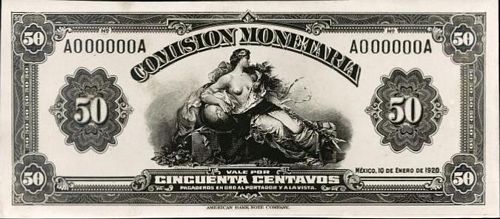
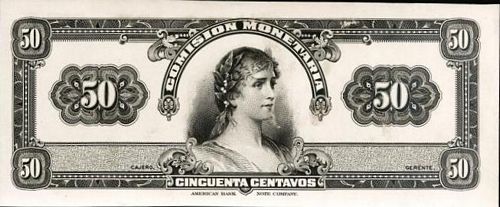 M4284 50c Comisión Monetaria proof
M4284 50c Comisión Monetaria proof
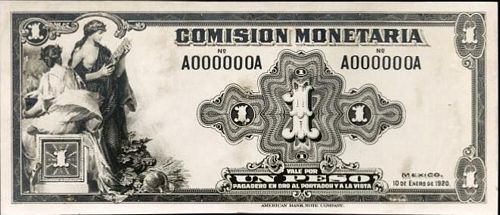
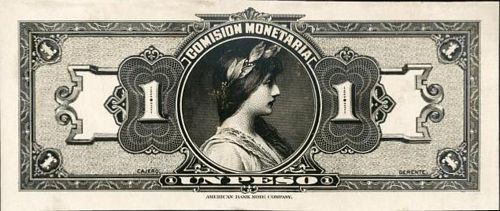 M4284.5 $1 Comisión Monetaria proof
M4284.5 $1 Comisión Monetaria proof
As mentioned earlier, these were generic vignettes from the ABNC and they were used for other issuing authorities over the time. The central vignette of the obverse of the 50 centavos model represents [ ][identification needed]. It was used on the 100 peso banknotes of the Banco Mercantil y Agrícola de Venezuela and on the 20 lempiras banknote from the Honduran Banco de la Atlántida, as well as on promotional stocks. On the reverse there is a bust of a young woman. The vignette of the one peso model has two women, one sitting and standing: it was used in the 25-dollar banknote of Bank of Hamilton in Canada. On the back, there is a woman's profile with a laurel wreath. This appears on the front of the 5 dollar bill of the Standard Bank of Canada and the 500,000 reis from Brazil in 1911.
Withdrawal from circulation
Several reasons explain the short duration of this issue. On the one hand, these vales did not meet the need for fractional currency of the small businessEl Informador, 10 February 1920. As early as October 1919, the silver content of 50 centavos coins was further reduced to 0.720 and 5, 10 and 20 centavos bronze coins began replacing silver coins. As it was not enough the population also began to use streetcar tickets, stamps, vouchers and other documents of less value to replace the lack of small coin.
In the last months of 1919 and during the first five of 1920 the Mint also minted a significant number of 2 and 2.50 pesos gold coins to facilitate relatively small transactions and also reduced the silver minting silver (only 623,000 pesos between January and May in 50 centavos coins). However, from June onwards it was resumed, with 190,000 pesos a dayInforme of President Adolfo de la Huerta, 1 September 1920 because the reduction of the international price of silver (graph 2) made it no longer interesting to hoard and export it, or necessary to issue the vales.
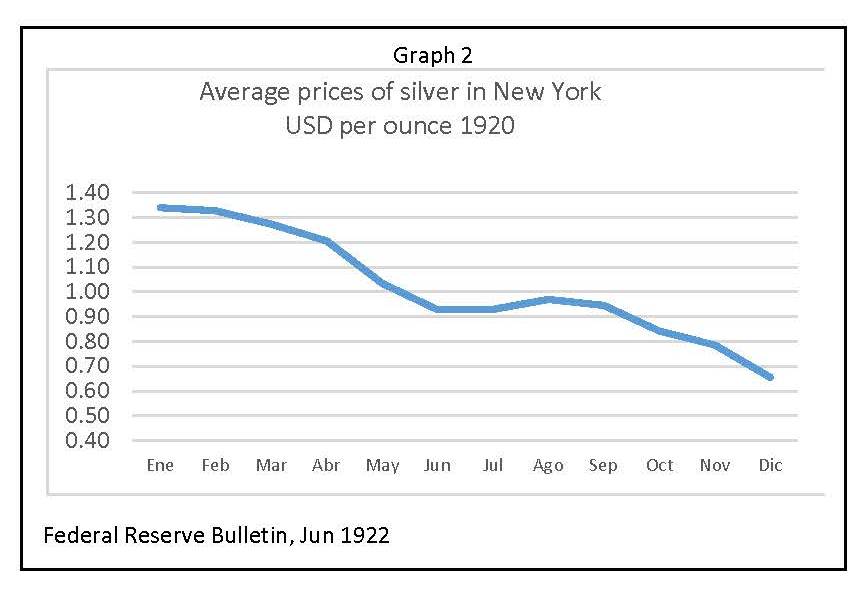 In addition, the population was still suspicious that one day Carranza’s government could decree (again) that paper money was no longer convertible or that it could depreciate quickly. This was exacerbated by the so-called coyotes who scattered mistrust, bought these vales at a discount and encouraged merchants not to accept them. Finally, on 21 May President Carranza was assassinated, generating great uncertainty and promoting the reorganization of the power groups in Mexico, leading to different solutions to the economic problems.
In addition, the population was still suspicious that one day Carranza’s government could decree (again) that paper money was no longer convertible or that it could depreciate quickly. This was exacerbated by the so-called coyotes who scattered mistrust, bought these vales at a discount and encouraged merchants not to accept them. Finally, on 21 May President Carranza was assassinated, generating great uncertainty and promoting the reorganization of the power groups in Mexico, leading to different solutions to the economic problems.
Gradually the shops stopped accepting them and the Ministry of Finance and the Monetary Commission withdrawing them. On 13 July the press reported a statement from the Vice Minister of Finance:
There are still three hundred thousand pesos in vales that have not been presented for collection, as the Government advised, to withdraw such fiduciary paper money from circulation. In order to make effective the withdrawal of this paper, the Government agreed to release a memorandum, leaving a certain period for the exchange of the "Vales Cabrera", in the offices of the Monetary Commission and the Confederation of Chambers of Commerce in this city, and in the branches of both institutions in the different states. The collecting offices have been ordered to send to Mexico City all the paper (money) in their possession, to make it effectiveEl Informador, 14 July 1920.
The following day, 14 July 1920, that is less than six months after its launch, the government of President Adolfo de la Huerta decreed the end of the issue. He also pointed out that 31 October was the deadline for citizens to exchange the vales in their possession, after which the government offices would stop receiving them and they would only be accepted directly at the Commission. The Confederation of Chambers of Commerce would then cease to participate in this process and the counting and incineration of the existing pieces would remain in the hands of the Monetary Commission, with the intervention of a Commissioner from the Department of the Comptroller's Office and another from the Ministry of Finance.
So far, I have not located any records for collected and destroyed vales. However, it is known that as of 1 September 1920, a total of 1,271,589 pesos in vales had been exchanged for gold coins. Thus, only about 71,000 pesos remained in circulation. Most likely, people continued to bring more vales to the Monetary Commission to exchange them. An inventory and balance book of the Monetary Commission in the National Archives indicates that as of 31 December 1928, the Commission still had a liability of 42,237 pesos, which gives us an idea of the amount of notes that were left without redemptionAGN, SC226 Comisión Monetaria, Caja 69, Libro de inventarios y balances..
(based on "The vales of the Comisión Monetaria: A brief paper money issue after the chaos of the revolution" by Cedrian López Bosch. USMexNA journal March 2017)

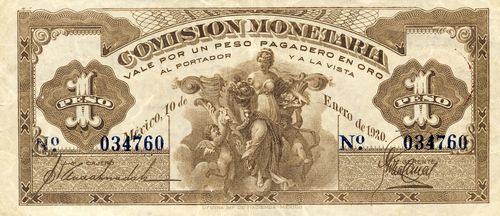
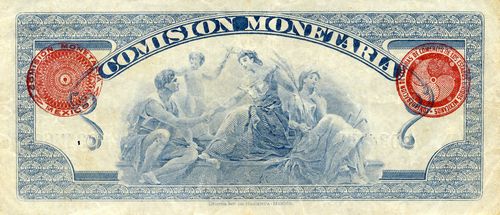 M4286 $1 Comisión Monetaria
M4286 $1 Comisión Monetaria